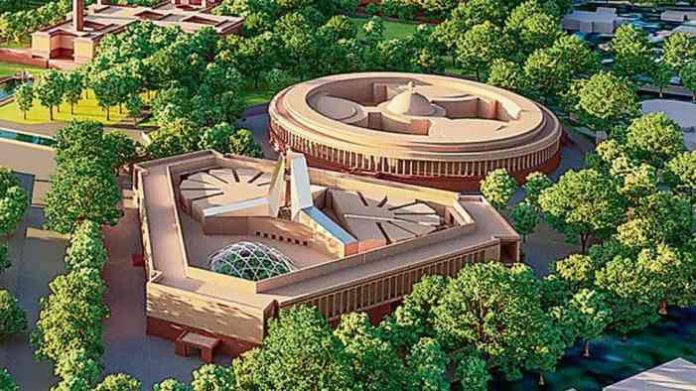Prime Minister Narendra Modi laid the foundation stone for the new Parliament building. The new Parliament building comes under the government’s ambitious Central Vista project. The Central Vista is a redevelopment project which entails building and refurbishing the government buildings on part of the 3-km Rajpath that stretches from Rashtrapati Bhavan to the iconic war memorial, India Gate. The existing Parliament building will be conserved as it is an archaeological asset of the country. It will be suitably retro-fitted to provide more functional spaces for parliamentary events, to ensure its usage along with the new building. The existing building is a massive circular edifice of 560 feet in diameter.
The new building was the need of the hour as it would be equipped with new technology and have more space for the smooth functioning of Parliament and various ministries. The building is an example of the co-existence of the new with the old. The project is expected to be completed by 2022 at an estimated cost of Rs 971 crore. The new Parliament will be a majestic representation of the world’s oldest civilisation and largest democracy blending it’s cultural diversity and modern infrastructure.

Some of the standout features of the new parliament are-
- The new building will have an area of 64,500 square metres. It will also have a grand Constitution Hall to showcase India’s democratic heritage, a lounge for members of Parliament, a library, multiple committee rooms, dining areas and ample parking space.
- In the new building, the Lok Sabha chamber will have a seating capacity for 888 members, while the Rajya Sabha will have 384 seats for members. The Lok Sabha chamber will have an option to increase its sitting capacity to 1,224 members during joint sessions. This has been done keeping in mind the future increase in the number of members for the two houses.
- The new building will not have a Central Hall. The building will be earthquake-resistant, and adaptable to the most modern digital technology. It will incorporate indigenous architecture from different parts of the country, and showcase cultural diversity.
- The new building will be fitted with advanced technology. Even common people, who want to share their grievances with their representatives, face trouble in the existing building due to paucity of space. The new building will have space for every MP to meet and address the issues of their constituents visiting them. The new building will fulfill the desire and aspirations of 21st century India.
- An adjacent building, which will come upon the site of Shram Shakti Bhavan, will have rooms for all MPs and will be connected via an underpass.
- Provisions will be made in the furniture for smart displays, biometrics for ease of voting, digital language interpretation or translation systems, and recording infrastructure to produce real-time metadata and programmable microphones.
- Interiors of the halls will be fitted with virtual sound simulations to set the right levels of reverberation sound and limit the echo.
- It will incorporate indigenous architecture from different parts of the country, and showcase cultural diversity.
- Around 2,000 people will be directly involved in its construction, while another 9,000 will be there indirectly.
- More than 200 artists from various parts of the country will also work for the building.
- A total of 120 office spaces, including committee rooms, major offices of the Ministry of Parliamentary Affairs, Lok Sabha Secretariat, Rajya Sabha secretariat, offices of the Prime Minister, some MPs and offices for staff and security personnel will be housed in the new Parliament. It will also have a reading room for MPs. It will not have a Central Hall.
- Lok Sabha chamber, which will come upon a 3,015 square metre area, will have 888 seats instead of the present 543 seats spread over an area of 1,145 square metre.
- Rajya Sabha chamber, spread over an area of 3,220 square metre, will have 384 seats against its current strength of 245 seats on 1,232 square metre area.
- During a joint session, the new Lok Sabha chamber will be able to accommodate 1,224 members.
- MPs will be seated in two-seater benches, which can accommodate three in case of joint sessions, in a horseshoe pattern in front of the Speaker.
- The seats will be 60 cm wide and 40 cm tall, bigger than the present seats that have a width of 45 cm and a height of 40 cm.
- The building will have six entrances: A ceremonial entrance for the President and Prime Minister; one for the Speaker of the Lok Sabha, Chairperson of the Rajya Sabha, and MPs; a ceremonial entrance in general; another entrance for MPs; and two public entrances.
- The office of all MPs in the new building will be equipped with the latest digital interfaces as a step towards creating ‘paperless offices’.
Project handling and design
The project of building the new Parliament Building has been given to Tata Projects Ltd. In September this year, Tata Projects Limited won the bid to construct the new Parliament building. The new building will be constructed close to the existing one under the Central Vista redevelopment project. The existing Parliament House building will be suitably retro-fitted to provide more functional spaces for parliamentary events, to ensure its usage along with the new building. The existing building is a massive circular edifice of 560 feet in diameter. The Parliament House Estate is enclosed by an ornamental red sandstone wall or iron grills with iron gates that can be closed when occasions demand. The building has twelve gates. The design of the building has been prepared by HCP Design, Planning and Management Pvt Ltd.

